Are you tired of your circular saw blade giving you subpar cuts? Ready to take your woodworking game to the next level? Look no further! This comprehensive DIY guide will walk you through the step-by-step process of changing out a circular saw blade, transforming your trusty tool into a precision cutting powerhouse. Whether you’re a seasoned pro or a novice enthusiast, mastering this essential skill will save you time, money, and frustration in the long run. So, grab your safety goggles, dust off your toolbox, and dive right in!
How does a circular saw work?
A circular saw is one of the most useful tools for cutting through wood and other materials. It consists of a motor that powers an abrasive blade, which can be changed out to cut different types and thicknesses of material. The blades themselves are typically made out of metal or carbide-tipped steel and come in various sizes and shapes depending on the type and thickness of the material being cut.
It is important to use the appropriate blade for your saw to get the best cutting performance. It is also important to make sure that the blade is properly secured before you begin using it, as blades that are not securely attached can create dangerous situations.
If you are swapping out blades often, it is also a good idea to use blade guards on your saw. These guards help to protect the user from any flying debris or dust created while cutting, as well as help to keep the blade from moving around during operation.
It’s important to remember that when doing any type of maintenance work with your circular saw, always be sure to wear proper eye and ear protection to help protect you from the risks associated with using power tools. Additionally, it is important to follow all safety instructions provided by the manufacturer of your circular saw for optimal performance and safety. With the right care and maintenance, your circular saw can last you a long time [1]!
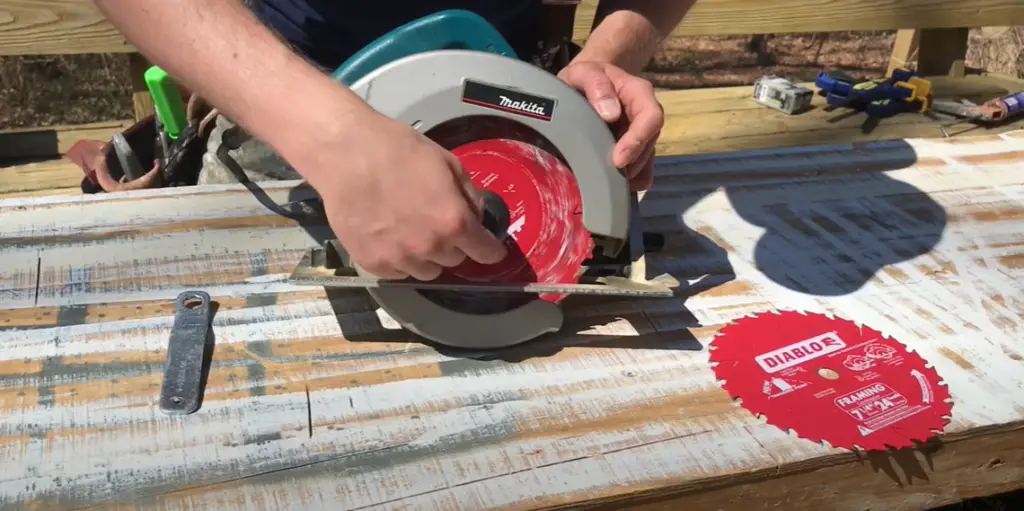
Types of circular saws
Worm drive circular saws
Worm-drive circular saws are highly favored among professional woodworkers and carpenters due to their exceptional power and outstanding performance. These saws are specifically designed to possess superior torque, surpassing that of a sidewinder, enabling them to effortlessly make deep cuts through even the toughest hardwoods. Moreover, their extended blade stick out allows for seamless execution of long cuts without the need to reposition the motor. Additionally, the positioning of the blade on the left side of the motor ensures an unobstructed view of the cut line, optimizing precision and accuracy during operation. With their remarkable capabilities and thoughtful design features, worm-drive circular saws have become an indispensable tool in the arsenal of woodworking professionals.
Sidewinder circular saws
Sidewinder circular saws are a great choice for DIYers and casual woodworkers who don’t need the extra power or heft of a worm drive saw. These saws usually come in smaller sizes which make them easier to maneuver and transport. Their lightweight construction also ensures that users won’t tire out as quickly when using one for extended periods. Additionally, the blade positioning on the right side of the motor enables a great view of the cut line, making it easy to follow precision lines or create intricate patterns. Above all else, sidewinder circular saws are much more affordable than their worm drive counterparts, making them the perfect option for those looking to economize on their tool purchases [2].
Types Of Circular Saw Blades
Standard Circular Saw Blades
Standard circular saw blades are a key component of any woodworking project, whether you’re working with hardwood or softwood. These blades are designed to cut through both materials in a way that leaves an accurate, smooth edge. They feature fewer teeth than other types, which is why they’re used for general purposes and ripping projects. Standard saw blades also come in a variety of sizes, so you can find the perfect fit for whatever project you have in mind. For example, if you’re cutting plywood, a 7.25-inch saw blade is ideal; for hardwoods or framing lumber, a 10-inch saw blade is the way to go.
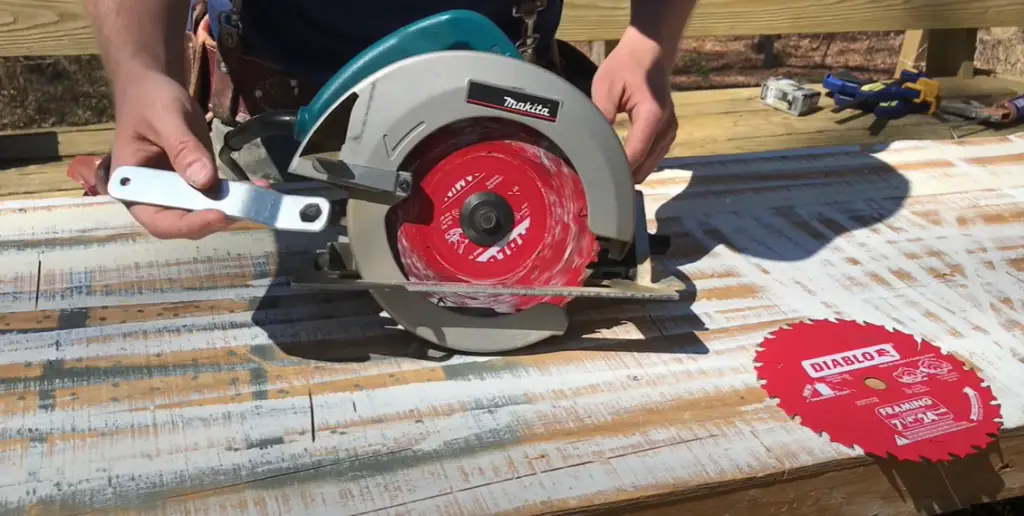
Continuous-Rim Blades
Continuous-rim blades, also known as continuous-edge or continuous-rim diamond blades, are an excellent choice for those seeking clean and accurate cuts without the hassle of messy debris. These saw blades are specifically designed with an uninterrupted rim, featuring teeth that wrap around the entire circumference of the blade. This unique design ensures prolonged contact between the cutting edges of the blade and the material being cut, resulting in even more precise and refined cuts. While continuous-rim blades are mainly intended for cutting materials like ceramic tile, marble, and granite, they can also be utilized for wood-cutting applications, providing versatility and convenience for various projects.
Turbo-Rim Blades
Turbo-rim blades, also known as turbo-cut or turbo-edge blades, boast a unique angled design that helps to provide cleaner and more efficient cuts. The sharp angles of the blade’s cutting edge allow for more airflow during the cutting process, which helps to reduce dust and debris buildup while still providing accurate results. Additionally, since they are designed with fewer teeth than standard saw blades, turbo-rim blades are great for making faster cuts through materials like wood, drywall, and PVC. Whether you’re working on a new remodel or an intricate carpentry project, these blades are sure to provide the results you need in record time.
Segmented Blades
Segmented blades are the go-to choice for any type of demolition or masonry project. These blades feature thicker segments with deeper gullets – the part of the blade between each individual tooth – which helps to reduce shoulder friction and produce more efficient cuts in hard materials. Additionally, because segmented blades have fewer teeth than standard saw blades, they can cut through materials like brick, stone, and concrete much faster than the alternatives. So if you’re looking for a saw model that can stand up to your toughest projects, then segmented blades are the perfect choice.
Abrasive Blades
Abrasive blades are an essential tool for any metal-cutting job, as they feature a unique design specifically designed to provide superior cutting performance. The bond of the blade’s abrasive grain ensures maximum contact between the material and the cutting edge of the blade, resulting in faster and more efficient cuts. Additionally, abrasive blades can be used on a variety of materials, including aluminum, copper, brass, and stainless steel. This makes them perfect for a variety of metal-cutting applications.
Cermet-Tipped Blades
Cermet-tipped blades are an ideal option for those seeking a fast and efficient way to cut through hard materials like stainless steel, Inconel, Hastelloy, and titanium. These blades feature a specialized ceramic-metal (cermet) tip that helps them remain sharp for longer periods than traditional saw blades. Additionally, cermet-tipped blades are designed to stay cool during the cutting process, helping to ensure optimal material integrity and reduced thermal distortion. So if you’re looking for a blade that can handle the toughest metal-cutting jobs, then cermet-tipped blades are the way to go.
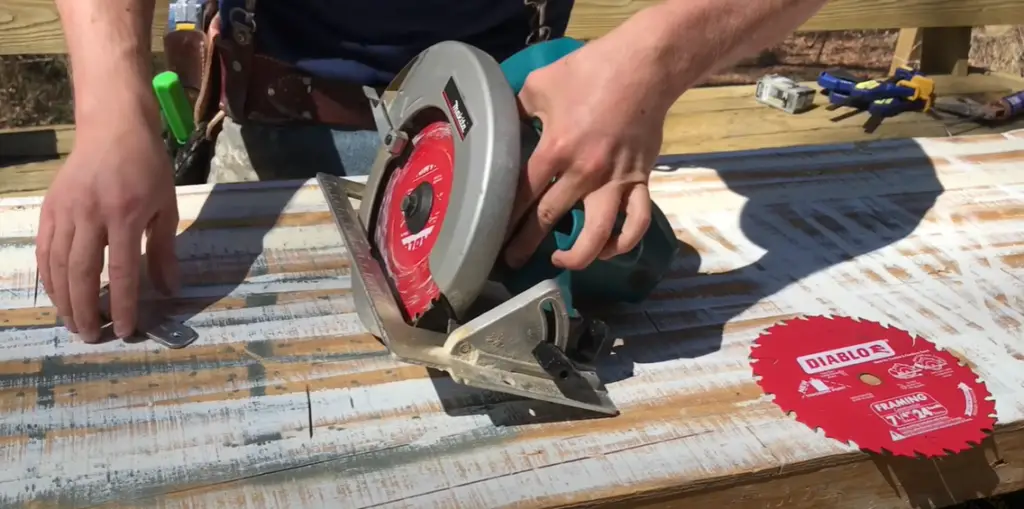
Stacked Dado Blades
Stacked dado blades are a great choice for those looking to make quick, accurate cuts in wood. These specialized saw blades come with two or more circular saw blades that stack together and can create incredibly precise dadoes (a triangular slot cut into the face of a board). Stacked dado blades can be used for making box joints, rabbets, grooves, and other joinery applications. By utilizing multiple blades, you can also adjust the width of your cuts by simply adding or removing individual blades from the stack. This makes stacked dado blades incredibly versatile while still providing quick and precise results for woodworking projects.
Diamond Blades
Finally, diamond blades are the best choice for any tile-cutting project. These specialized blades have an impregnated layer of diamonds that helps them last longer and provide superior performance when cutting materials like ceramic, porcelain, and marble. Diamond blades also feature a unique “turbo” segmented design that helps to ensure smooth and precise cuts every time. So if you’re looking for a saw blade that can tackle your toughest tile-cutting jobs, then diamond blades are the way to go [3].
Circular Saw Cutting Tips
Saw blades are a key piece of equipment for any woodworking project. Whether you’re cutting through hardwood or softwoods, you need to pay special attention to the type of saw blade you use and its sharpness. A dull blade can cause chipping, tear-outs, and poor cuts in your workpiece. To ensure the best possible results, you should consider swapping out your saw blade for a new one regularly.
Here are some tips to help you choose the right circular saw blade:
- Consider the material you’re cutting. Different materials require different types of blades; hardwoods need fine-toothed blades while softwoods should be cut with coarse-toothed blades.
- Look at the number of teeth on the blade; more teeth provide a smoother cut, while fewer teeth mean faster cutting but rougher edges.
- Check if your saw blade is carbide-tipped or standard steel. Carbide-tipped blades last longer and can be used for harder materials, but cost significantly more than standard steel blades.
- Make sure your saw blade is well-aligned with the saw table, and that it’s tightened properly onto the arbor. A misaligned or loose blade can cause blowouts and inaccurate cuts.
- Be sure to wear protective gear when working with circular saw blades; goggles are essential for protecting your eyes from flying debris, while gloves can protect your hands from cuts and scrapes.
Following these tips will help you get the best results out of your circular saw blade, ensuring better cuts and a longer life for your saw blades. Plus, swapping out dull blades regularly will save you money on replacement costs in the long run!
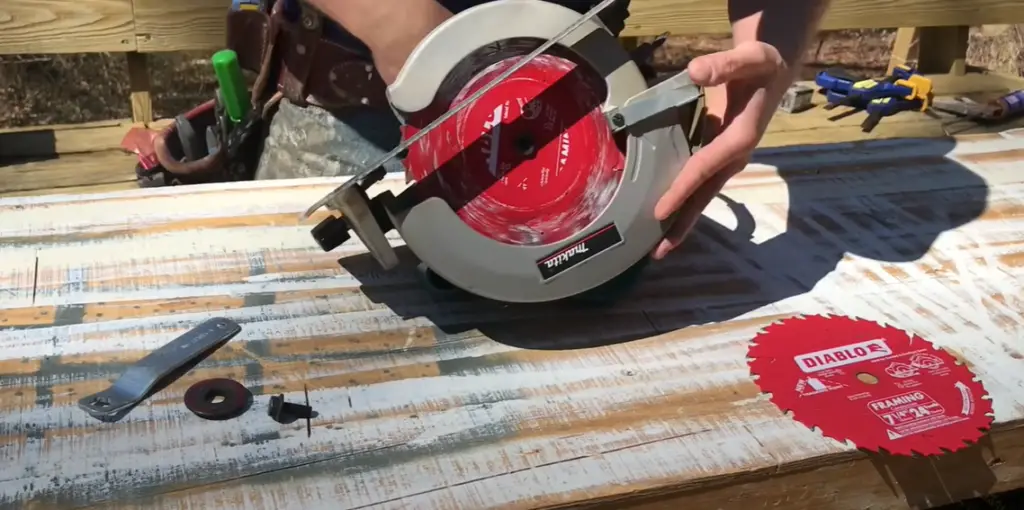
How to Change a Circular Saw Blade
STEP 1: Disconnect the circular saw from its power source
Before you start the process of replacing your circular saw blade, it is crucial to ensure that the tool is completely unplugged from any power source. This simple yet vital step will provide you with the utmost safety while working with the sharp blades and other intricate components of the saw, reducing the risk of any accidents or mishaps. By taking this precautionary measure, you can have peace of mind and confidently proceed with the blade-swapping process, knowing that you have prioritized your safety.
STEP 2: Locate the circular saw wrench stored on the tool.
The circular saw wrench is a specialized tool that is specifically designed for the circular saw. It is typically included with the saw and is an indispensable accessory for any user. This handy tool features two smaller wrenches connected in the middle, allowing for easy and secure handling. To locate it, you can typically find the circular saw wrench conveniently stored in the area where the blade is situated. Take your time to ensure you have this tool readily available, as it is of utmost importance when it comes to safely removing and replacing the blade. With the circular saw wrench in hand, you can confidently tackle your cutting tasks with precision and efficiency.
STEP 3: Depress the spindle-lock button to keep the saw blade from spinning.
The spindle-lock button is located on the side of the circular saw and helps to keep the blade from spinning while you’re working with it. To use this feature, press down firmly on the spindle-lock button until it clicks into place. This will prevent any unwanted movement of the circular saw blade while your hands are occupied elsewhere. After depressing the spindle-lock button, you can now safely start removing the old blade.
STEP 4: Use the circular saw wrench to loosen the bolt that holds the blade in place.
Now that the spindle-lock button has been depressed, you can use the circular saw wrench to loosen and remove the bolt holding the blade in place. As you turn the wrench counterclockwise, be sure to keep a firm grip on your tool and take special care not to let it slip or drop. Once the bolt is loosened, you’ll be able to remove the old blade from your circular saw.
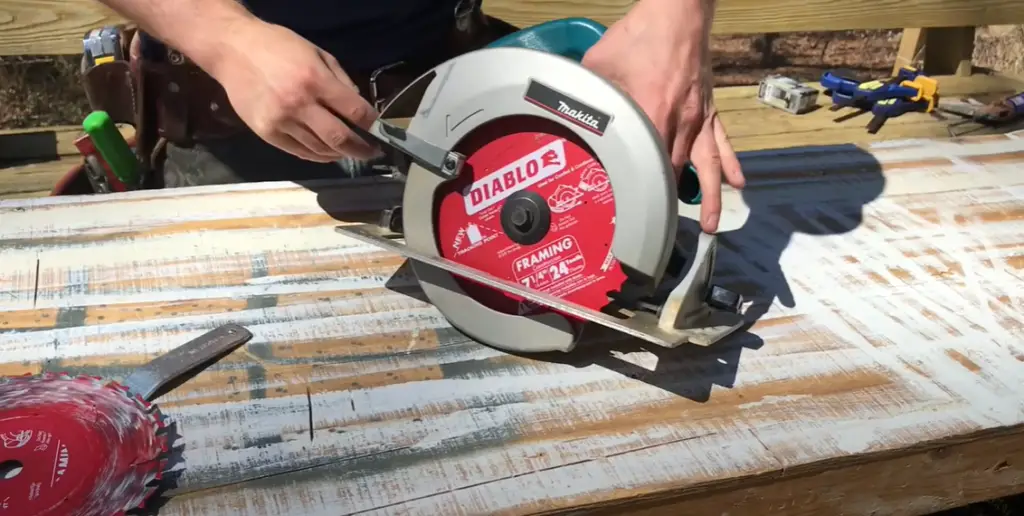
STEP 5: Push the blade guard out of the way to remove the old blade.
Once the bolt has been loosened and removed, you can now push the blade guard out of the way. This will afford you a clear view of the circular saw blade, allowing you to safely remove it. Take your time when removing the old blade and handle it with care in order to avoid any accidents or injuries.
STEP 6: Slip the new blade in place and replace the bolt.
Now that you have successfully removed the old blade, it is time to replace it with a new one. Gently slip the new blade into the saw and ensure that it is securely positioned in place. Once you have checked that everything is properly aligned, firmly turn the bolt clockwise with your circular saw wrench to securely fasten it into place [4].
Circular saw safety procedures
A circular saw is an incredibly powerful tool–but it can also be incredibly dangerous. To ensure that everyone stays safe while using a circular saw, these safety procedures should always be followed:
- Always wear protective clothing and eyewear when using a circular saw;
- Make sure to have a clear view of your work surface before starting any cutting job;
- Secure the workpiece firmly in place with clamps or a vise before beginning to cut;
- Always keep your hands away from the blade while the saw is running; and
- Make sure to always unplug the saw before performing any maintenance or replacing blades.
When it comes time to replace a circular saw blade, it’s important to choose the right type for the job. Consider factors like blade diameter, material type, and tooth count when selecting a new blade. You should also inspect the saw blade regularly for signs of wear and tear, such as cracks or chips in the teeth. If you notice any damage to your saw blade, it’s best to err on the side of caution and replace it.
By following these safety procedures and taking the time to properly select and install a circular saw blade, you can ensure that every cutting job is as safe and accurate as possible.
Circular Saw Maintenance Tips For a Better Blade Swap
When it comes to circular saw blade swaps, it’s important to take the time to properly maintain your blades. Doing so will help ensure that you get a cleaner cut and longer life out of your circular saw blades. Here are some maintenance tips that you can use when swapping out circular saw blades:
- Clean the arbor before installing a new blade. Use an old toothbrush and some soapy water to remove sawdust that may be gathered on the arbor, as this can interfere with the smooth installation of the new blade.
- Securely tighten the arbor bolt when installing a new blade. Make sure it is tight enough to keep the blade in place but not too tight that it can cause damage to the saw motor.
- Inspect the blade for any damage or wear before installing it. If there is excess wear, do not use the blade as it could result in an unsafe operation of your circular saw.
- Use a lubricant when swapping out blades to reduce friction and make sure that it will move properly once installed on the arbor.
- Make sure to store your circular saw blades in a cool and dry place when not in use. This helps to prevent rusting and other damage that can occur over time.
Taking the time to properly maintain your circular saw blades will ensure that they stay sharp and perform their best for years to come. Follow these maintenance tips and you’ll be well on your way to a successful blade swap!
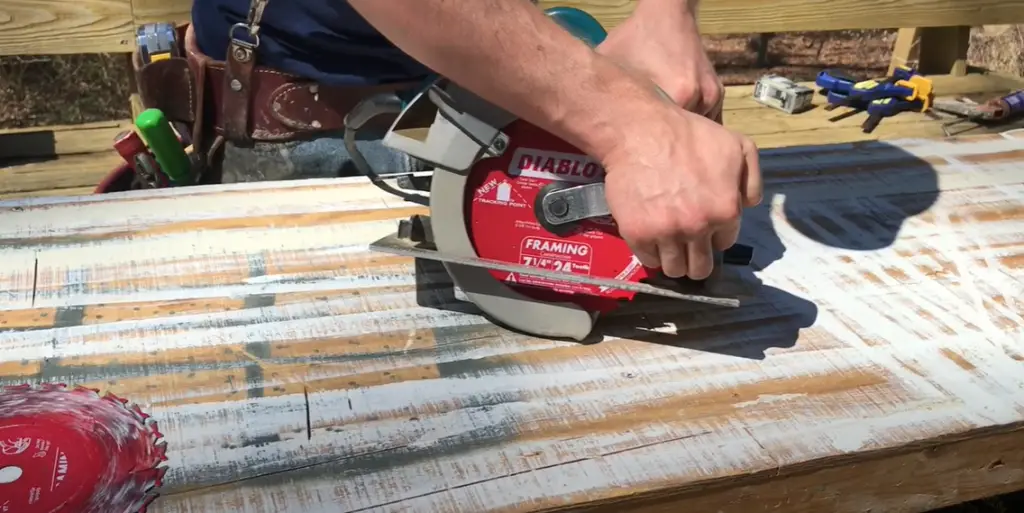
FAQ
What is the difference between a rotary saw and a circular saw?
A rotary saw is a type of circular saw that is designed for repeated, short rotations of the blade. This makes it well-suited to cutting and shaping materials such as wood, plastic, metal and masonry. A circular saw, on the other hand, is a power tool driven by an electric motor that uses a toothed or abrasive disc or blade to cut various materials. Rotary saws are generally more precise and easier to control than circular saws, while circular saws are better suited for larger, rougher cuts.
Can I replace the blades on my circular saw by myself?
Yes, you can replace the blades on your circular saw by yourself. The process is relatively simple and requires having a compatible replacement blade for your saw as well as some basic tools such as pliers, wrenches and screwdrivers. Before beginning, make sure to disconnect the power source to ensure safety during the blade swap. Once you have done this, carefully remove the old blade from the saw and replace it with the new one, making sure all screws are tight. Finally, test your saw to make sure that it is working properly before using for any task.
Is a circular saw a jigsaw?
No, a circular saw is not a jigsaw. While both are power tools that use blades to cut materials, their designs are different. A jigsaw uses a reciprocating blade that moves up and down while cutting material such as wood and metal, whereas a circular saw has a round blade that spins at high speeds to make cuts. In addition, the blades of a jigsaw and circular saw are designed differently. Jigsaw blades have alternating sharp-toothed edges while circular saw blades have evenly spaced teeth around the circumference of the blade.
Useful Video: How To Change Circular Saw Blades
Conclusion
To change a circular saw blade safely and quickly, understanding the potential danger and taking the necessary safety precautions is essential. By following the steps outlined above, you can successfully swap out your circular saw blade without any difficulty. Remember to always wear protective gear such as goggles, gloves, and ear protection when operating power tools to protect yourself from potential injury or harm. With the right technique and safety measures, you can easily replace your circular saw blade in no time. Have fun and stay safe!
References:
- https://www.toolstop.co.uk/blog/knowledge-base/how-to-use-a-circular-saw#
- https://toolshaven.com/types-of-circular-saws/
- https://benchmarkabrasives.com/blogs/news/what-are-different-types-of-circular-saw-blades
- https://www.bobvila.com/articles/how-to-change-a-circular-saw-blade/















Leave a Reply